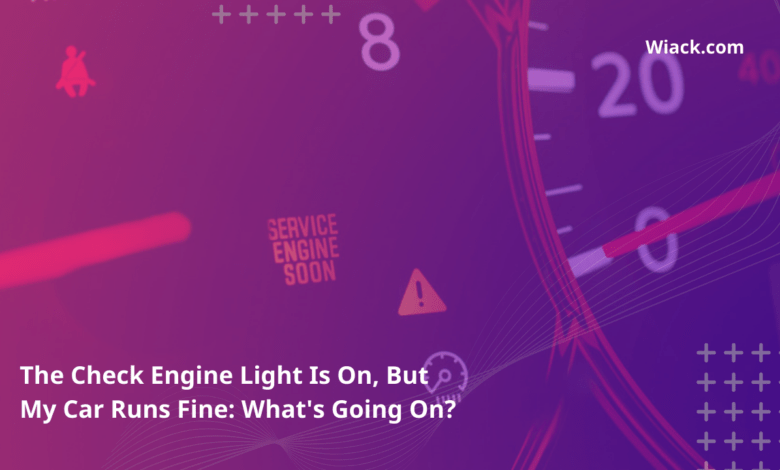The Check Engine Light Is On, But My Car Runs Fine: What’s Going On?

Did you know that approximately 10% of all vehicles on the road have their check engine light on at any given time? This surprising statistic highlights how common this issue is, yet many drivers continue to operate their vehicles without addressing the underlying cause. In this comprehensive guide, we’ll explore why your check engine light might be illuminated even when your car runs fine, and what steps you should take to ensure your vehicle’s longevity and safety.
What Does the Check Engine Light Mean?
Understanding the Check Engine Light’s Purpose
The check engine light, also known as the Malfunction Indicator Lamp (MIL), is a crucial component of your vehicle’s onboard diagnostics system. Its primary purpose is to alert you when the car’s computer detects a problem with the engine, transmission, or emissions control system. This warning system has been mandatory in all vehicles sold in the United States since 1996, as part of the OBD-II (On-Board Diagnostics II) standard.
When your car’s computer identifies an issue, it stores a corresponding error code and illuminates the check engine light. This light is designed to catch your attention and prompt you to investigate the problem, even if your car runs fine to the naked eye. It’s important to understand that the light doesn’t necessarily indicate an immediate, catastrophic failure. Instead, it serves as an early warning system to prevent minor issues from escalating into major, costly repairs.
Solid vs. Flashing Check Engine Light
Not all check engine light warnings are created equal. The way the light behaves can provide valuable information about the severity of the problem:
- Solid Light: A steady, continuous illumination typically indicates a less urgent issue. While you should still address the problem promptly, it’s usually safe to continue driving for a short period. Many of the reasons we’ll discuss in this article fall into this category, where the check engine light is on but car runs fine.
- Flashing Light: If your check engine light is blinking or flashing, it signals a more serious problem that requires immediate attention. This often indicates an engine misfire that could lead to catalytic converter damage. In this case, you should reduce speed, minimize engine load, and seek professional help as soon as possible.
Understanding the difference between these two signals can help you gauge the urgency of the situation and decide on the appropriate course of action.
Common Reasons for a Check Engine Light When the Car Runs Fine
Even when your car runs fine, there are several reasons why your check engine light might be illuminated. Let’s explore some of the most common causes:
Loose or Faulty Gas Cap
Believe it or not, a loose or damaged gas cap is one of the most frequent reasons for a check engine light to come on. Your gas cap plays a crucial role in maintaining the pressure in your fuel system and preventing fuel vapors from escaping into the atmosphere. When it’s not properly sealed, your car’s evaporative emissions system (EVAP) detects a leak and triggers the warning light.
To address this issue:
- Pull over safely and turn off the engine.
- Locate your gas cap and ensure it’s tightened properly.
- If the cap feels loose or doesn’t click when you tighten it, it may need replacement.
- After securing or replacing the cap, drive for a few days to see if the light turns off on its own.
This simple fix often resolves the issue, allowing you to continue driving while your car runs fine.
Faulty Oxygen Sensor (O2 Sensor)
Oxygen sensors play a critical role in your vehicle’s fuel efficiency and emissions control. These sensors monitor the amount of unburned oxygen in your exhaust system and help the engine adjust the air-fuel mixture for optimal performance. When an O2 sensor fails, it can cause your engine to run less efficiently, even if your car runs fine to the casual observer.
Symptoms of a faulty O2 sensor may include:
- Decreased fuel efficiency
- Rough idling or hesitation during acceleration
- Increased emissions
While your car may continue to operate normally for a while, ignoring a faulty O2 sensor can lead to more significant problems down the road, including catalytic converter damage.
Bad Mass Airflow Sensor (MAF Sensor)
The mass airflow sensor measures the amount of air entering your engine, allowing the computer to adjust the fuel injection accordingly. When this sensor malfunctions, it can cause a variety of issues, even if your car runs fine most of the time.
Common symptoms of a bad MAF sensor include:
- Hesitation during acceleration
- Rough idling
- Stalling shortly after starting
- Decreased fuel efficiency
In many cases, a faulty MAF sensor won’t cause immediate drivability issues, which is why your check engine light might be on while your car runs fine. However, addressing this problem promptly can prevent more serious engine damage and maintain optimal performance.
Dirty or Bad MAF Sensor
Sometimes, a MAF sensor doesn’t need to be replaced entirely; it might just need cleaning. Over time, dirt and debris can accumulate on the sensor, causing it to provide inaccurate readings to the engine control unit (ECU). This can trigger the check engine light even when your car runs fine in most situations.
To clean your MAF sensor:
- Locate the sensor (usually between the air filter and engine intake manifold).
- Carefully remove the sensor.
- Use a specialized MAF sensor cleaner spray to clean the sensor element.
- Allow the sensor to dry completely before reinstalling.
Remember, always consult your vehicle’s manual before attempting any DIY maintenance, and if you’re unsure, it’s best to seek professional help.
Damaged Wiring Between Sensors and the ECU
Your vehicle’s electrical system is complex, with numerous sensors communicating constantly with the ECU. Sometimes, the check engine light can be triggered by damaged or corroded wiring between these components, even when your car runs fine otherwise.
Common causes of wiring issues include:
- Rodent damage (mice or rats chewing on wires)
- Corrosion from exposure to moisture or road salt
- Physical damage from road debris or improper repairs
While your car may continue to operate normally for a while, addressing wiring issues promptly is crucial to prevent more serious electrical problems down the line.
Incorrect Fuel Type
Using the wrong type of fuel can trigger your check engine light, even if your car runs fine in the short term. This is particularly common when drivers accidentally use regular gasoline in a vehicle that requires premium fuel, or vice versa.
While modern engines are designed to adjust to different fuel grades to some extent, consistently using the wrong type can lead to:
- Reduced performance
- Decreased fuel efficiency
- Potential long-term engine damage
If you suspect you’ve used the wrong fuel type, it’s best to have your vehicle checked by a professional to ensure no lasting damage has occurred.
Other Emissions System Components
Your vehicle’s emissions control system is complex, with many components working together to reduce harmful exhaust emissions. When any part of this system malfunctions, it can trigger the check engine light, even if your car runs fine to the casual observer.
Common emissions system components that can cause issues include:
- EGR (Exhaust Gas Recirculation) valve
- PCV (Positive Crankcase Ventilation) valve
- EVAP (Evaporative Emission Control) system components
While these issues may not immediately affect your car’s performance, addressing them promptly is crucial for maintaining optimal fuel efficiency and passing emissions tests.
Catalytic Converter Issues
The catalytic converter is a crucial component of your vehicle’s emissions control system, responsible for converting harmful exhaust gases into less harmful substances. While a failing catalytic converter can often cause noticeable performance issues, in some cases, your car runs fine even as problems begin to develop.
Signs of a failing catalytic converter may include:
- Reduced acceleration
- Decreased fuel efficiency
- A sulfuric, rotten egg-like smell from the exhaust
If your check engine light is on due to catalytic converter issues, it’s essential to address the problem promptly, as replacements can be expensive and continued operation may lead to more severe engine damage.
Engine Overheating
While severe overheating usually causes noticeable performance issues, mild overheating can trigger the check engine light even when your car runs fine otherwise. This can be caused by:
- Low coolant levels
- Faulty thermostat
- Malfunctioning cooling fan
- Leaks in the cooling system
Regular maintenance and monitoring of your vehicle’s cooling system can help prevent overheating issues and the associated check engine light warnings.
Engine Misfire
An engine misfire occurs when one or more cylinders fail to fire properly, disrupting the engine’s smooth operation. While severe misfires cause noticeable performance issues, minor misfires can trigger the check engine light even when your car runs fine to the casual observer.
Common causes of engine misfires include:
- Worn spark plugs
- Faulty ignition coils
- Vacuum leaks
- Fuel injector problems
Addressing misfires promptly is crucial to prevent damage to your catalytic converter and maintain optimal engine performance.
Malfunctioning EGR Valve
The Exhaust Gas Recirculation (EGR) valve helps reduce nitrogen oxide emissions by recirculating a portion of exhaust gases back into the engine. When this valve malfunctions, it can trigger the check engine light even if your car runs fine most of the time.
Symptoms of a faulty EGR valve may include:
- Rough idling
- Decreased fuel efficiency
- Increased emissions
- Knocking or pinging sounds from the engine
Regular maintenance and cleaning of the EGR valve can help prevent these issues and keep your check engine light off.
What to Do When the Check Engine Light Is On
When your check engine light comes on, even if your car runs fine, it’s important to take action. Here’s a step-by-step guide on what to do:
Identify the Problem
The first step is to identify the specific issue triggering the check engine light. Here’s how:
- Use an OBD-II Scanner: These devices plug into your car’s diagnostic port and read the error codes stored in the computer. Many auto parts stores offer free code reading services.
- Check for Simple Issues: Inspect your gas cap and other easily accessible components for obvious problems.
- Monitor Your Car’s Performance: Pay attention to any subtle changes in how your car runs, even if it seems fine overall.
Get Your Car Diagnosed
Once you have the error code(s), it’s time to get a proper diagnosis:
- Research the Code: Look up the meaning of the code online or in your vehicle’s manual.
- Consult a Professional: If you’re unsure about the diagnosis or how to fix the issue, consult a qualified mechanic.
- Consider Multiple Issues: Remember that a single code can sometimes indicate multiple potential problems.
Clear the Code and Monitor the Light
After addressing the issue:
- Clear the Code: Use the OBD-II scanner to clear the error code from your car’s computer.
- Monitor the Light: Drive your car for several days to see if the check engine light comes back on.
- Recheck if Necessary: If the light returns, you may need to dig deeper or seek professional help.
Seek Professional Help
If you’re unable to identify or fix the issue yourself:
- Choose a Reputable Mechanic: Look for certified professionals with good reviews.
- Provide Information: Tell the mechanic about any codes you’ve read and symptoms you’ve noticed.
- Ask Questions: Don’t hesitate to ask for explanations about the diagnosis and recommended repairs.
- Get a Second Opinion: For expensive repairs, consider getting a second opinion to ensure accuracy.
Check Engine Light False Alarms
While the check engine light is an important warning system, it’s not infallible. Sometimes, the light can come on due to temporary glitches or false alarms.
Computer Errors
Modern vehicles rely heavily on complex computer systems, which can occasionally experience errors:
- Temporary Glitches: Sometimes, a momentary sensor glitch can trigger the light, even when there’s no ongoing issue.
- Software Updates: In rare cases, your vehicle’s computer may need a software update to resolve persistent false alarms.
- Battery Issues: A weak or recently replaced battery can sometimes cause temporary electrical system irregularities, triggering the light.
If you suspect a false alarm:
- Clear the code using an OBD-II scanner.
- Monitor your vehicle closely for any recurring issues.
- If the light returns frequently without apparent cause, consult a professional to check for underlying electrical or computer problems.
Remember, while false alarms do occur, it’s always better to err on the side of caution and investigate any check engine light warnings, even if your car runs fine.
Additional Considerations
Importance of Prompt Action
Even when your car runs fine, addressing a check engine light promptly is crucial:
- Prevent Escalation: Minor issues can develop into major problems if left unchecked.
- Maintain Efficiency: Many check engine light triggers affect fuel efficiency, costing you money over time.
- Ensure Safety: Some issues that trigger the light can compromise your vehicle’s safety if ignored.
- Avoid Costly Repairs: Addressing problems early often prevents more expensive repairs down the line.
Potential Long-Term Consequences
Ignoring your check engine light, even when your car runs fine, can lead to:
- Reduced Vehicle Lifespan: Ongoing minor issues can cause cumulative damage over time.
- Decreased Resale Value: A history of ignored warning lights can make your car less attractive to potential buyers.
- Failed Emissions Tests: Many areas require passing an emissions test for vehicle registration.
- Voided Warranty: Some manufacturers may void parts of your warranty if you ignore warning lights.
Safety Precautions
While many check engine light issues don’t pose immediate safety risks, it’s important to:
- Be Prepared: Keep basic emergency supplies in your car, including a flashlight, basic tools, and a phone charger.
- Know Your Limits: If you’re unsure about diagnosing or repairing an issue, seek professional help.
- Stay Alert: Pay close attention to any changes in your vehicle’s performance, even if it generally runs fine.
- Regular Maintenance: Keep up with scheduled maintenance to prevent many common check engine light triggers.
In conclusion, while it can be tempting to ignore a check engine light when your car runs fine, doing so can lead to more significant problems down the road. By understanding the common causes, taking prompt action, and seeking professional help when needed, you can ensure your vehicle remains safe, efficient, and reliable for years to come. Remember, a little attention now can save you a lot of trouble and expense in the future.
Get the latest car news, reviews, and prices at Wiack.com. Your one-stop destination for all things automotive.





